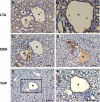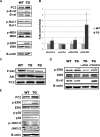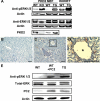Cyst formation in kidney via B-Raf signaling in the PKD2 transgenic mice
- PMID: 19098310
- PMCID: PMC2652279
- DOI: 10.1074/jbc.M805890200
Cyst formation in kidney via B-Raf signaling in the PKD2 transgenic mice
Abstract
The pathogenic mechanisms of human autosomal dominant polycystic kidney disease (ADPKD) have been well known to include the mutational inactivation of PKD2. Although haploinsufficiency and loss of heterozygosity at the Pkd2 locus can cause cyst formation in mice, polycystin-2 is frequently expressed in the renal cyst of human ADPKD, raising the possibility that deregulated activation of PKD2 may be associated with the cystogenesis of human ADPKD. To determine whether increased PKD2 expression is physiologically pathogenic, we generated PKD2-overexpressing transgenic mice. These mice developed typical renal cysts and an increase of proliferation and apoptosis, which are reflective of the human ADPKD phenotype. These manifestations were first observed at six months, and progressed with age. In addition, we found that ERK activation was induced by PKD2 overexpression via B-Raf signaling, providing a possible molecular mechanism of cystogenesis. In PKD2 transgenic mice, B-Raf/MEK/ERK sequential signaling was up-regulated. Additionally, the transgenic human polycystin-2 partially rescues the lethality of Pkd2 knock-out mice and therefore demonstrates that the transgene generated a functional product. Functional strengthening or deregulated activation of PKD2 may be a direct cause of ADPKD. The present study provides evidence for an in vivo role of overexpressed PKD2 in cyst formation. This transgenic mouse model should provide new insights into the pathogenic mechanism of human ADPKD.
Figures








Similar articles
-
Human polycystin-2 transgene dose-dependently rescues ADPKD phenotypes in Pkd2 mutant mice.Am J Pathol. 2015 Oct;185(10):2843-60. doi: 10.1016/j.ajpath.2015.06.014. Am J Pathol. 2015. PMID: 26435415 Free PMC article.
-
Rapamycin treatment dose-dependently improves the cystic kidney in a new ADPKD mouse model via the mTORC1 and cell-cycle-associated CDK1/cyclin axis.J Cell Mol Med. 2017 Aug;21(8):1619-1635. doi: 10.1111/jcmm.13091. Epub 2017 Feb 28. J Cell Mol Med. 2017. PMID: 28244683 Free PMC article.
-
Mitochondrial Abnormality Facilitates Cyst Formation in Autosomal Dominant Polycystic Kidney Disease.Mol Cell Biol. 2017 Nov 28;37(24):e00337-17. doi: 10.1128/MCB.00337-17. Print 2017 Dec 15. Mol Cell Biol. 2017. PMID: 28993480 Free PMC article.
-
Molecular and cellular pathogenesis of autosomal dominant polycystic kidney disease.Braz J Med Biol Res. 2011 Jul;44(7):606-17. doi: 10.1590/s0100-879x2011007500068. Epub 2011 May 27. Braz J Med Biol Res. 2011. PMID: 21625823 Review.
-
Three-dimensional in vitro models answer the right questions in ADPKD cystogenesis.Am J Physiol Renal Physiol. 2018 Aug 1;315(2):F332-F335. doi: 10.1152/ajprenal.00126.2018. Epub 2018 Apr 25. Am J Physiol Renal Physiol. 2018. PMID: 29693448 Free PMC article. Review.
Cited by
-
Genome-wide methylation profiling of ADPKD identified epigenetically regulated genes associated with renal cyst development.Hum Genet. 2014 Mar;133(3):281-97. doi: 10.1007/s00439-013-1378-0. Epub 2013 Oct 16. Hum Genet. 2014. PMID: 24129831
-
Cyclic AMP-mediated cyst expansion.Biochim Biophys Acta. 2011 Oct;1812(10):1291-300. doi: 10.1016/j.bbadis.2010.11.005. Epub 2010 Nov 28. Biochim Biophys Acta. 2011. PMID: 21118718 Free PMC article. Review.
-
The lonidamine derivative H2-gamendazole reduces cyst formation in polycystic kidney disease.Am J Physiol Renal Physiol. 2022 Oct 1;323(4):F492-F506. doi: 10.1152/ajprenal.00095.2022. Epub 2022 Aug 18. Am J Physiol Renal Physiol. 2022. PMID: 35979967 Free PMC article.
-
Molecular Mechanisms of Epigenetic Regulation, Inflammation, and Cell Death in ADPKD.Front Mol Biosci. 2022 Jun 29;9:922428. doi: 10.3389/fmolb.2022.922428. eCollection 2022. Front Mol Biosci. 2022. PMID: 35847973 Free PMC article. Review.
-
Polycystic kidney disease - where gene dosage counts.F1000Prime Rep. 2014 Apr 1;6:24. doi: 10.12703/P6-24. eCollection 2014. F1000Prime Rep. 2014. PMID: 24765529 Free PMC article. Review.
References
-
- Gabow, P. A. (1993) N. Engl. J. Med. 329 332-342 - PubMed
-
- Grantham, J. J. (1996) Am. J. Kidney Dis. 28 788-803 - PubMed
-
- Carone, F. A., Bacallao, R., and Kanwar, Y. S. (1996) The etiology, pathogenesis, and treatment of autosomal dominant polycystic kidney disease: recent advances, pp. 111-124, Oxford University Press, Oxford, UK
-
- Peters, D. J., and Sandkuijl, L. A. (1992) Contrib. Nephrol. 97 128-139 - PubMed
-
- Roscoe, J. M., Brissenden, J. E., Williams, E. A., Chery, A. L., and Silverman, M. (1993) Kidney Int. 44 1101-1108 - PubMed
Publication types
MeSH terms
Substances
LinkOut - more resources
Full Text Sources
Other Literature Sources
Molecular Biology Databases
Research Materials
Miscellaneous

